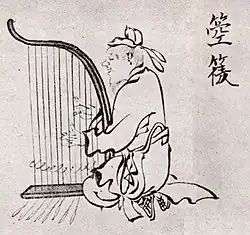箜篌
Chinese
| phonetic | |||
|---|---|---|---|
| trad. (箜篌) | 箜 | 篌 | |
| simp. #(箜篌) | 箜 | 篌 | |
Etymology
In the Records of the Grand Historian 《史記·封禪書》 it was attested as the form 空侯 (OC *kʰoːŋ ɡoː) during the reign of the Emperor Wu of Han [111 BCE]. It is uncertain whether the later instrument bearing the (orthographically normalised) name 箜篌 had inherited from the Han-era one. The name might have originated as transcription of a foreign term from the west.
Compare Sogdian [script needed] (cngryʾ /čangaryā/), [script needed] (cyngryʾ /čingaryā/), both names of this instrument in the Sogdian language, as well as Persian چنگ (čang) and the Turkic harp of çeng. (Can this(+) etymology be sourced?)
Pronunciation
Noun
箜篌
- (music, chiefly historical) a term used to refer to one of a number of different plucked string instruments (mostly harps) used in the music of ancient China
Usage notes
- This instrument has been revived in modernized form in the 20th century.
Alternative forms
- 空侯
Synonyms
- 坎侯
Derived terms
|
|
Japanese
| Kanji in this term | |
|---|---|
| 箜 | 篌 |
| く>くう Hyōgaiji | ご Hyōgaiji |
| irregular | kan’yōon |
| Kanji in this term | |
|---|---|
| 箜 | 篌 |
| く Hyōgaiji | ご Hyōgaiji |
| goon | kan’yōon |

Etymology
From Old Japanese. First attested in a text from 780.[1]
Also found with the lengthened reading kūgo. This appears to be less commonly used.[1][2][3]
Pronunciation
Standard:
- (Tokyo) くご [kúꜜgò] (Atamadaka – [1])[3]
- IPA(key): [kɯ̟ᵝɡo̞]
Lenthened:
- (Tokyo) くうご [kúꜜùgò] (Atamadaka – [1])[3]
- IPA(key): [kɯ̟ᵝːɡo̞]
Noun
箜篌 or 箜篌 • (kugo or kūgo)
- a konghou, a kind of ancient Chinese harp
Synonyms
- 百済琴 (kudaragoto)
References
- 1988, 国語大辞典(新装版) (Kokugo Dai Jiten, Revised Edition) (in Japanese), Tōkyō: Shogakukan
- 1995, 大辞泉 (Daijisen) (in Japanese), Tōkyō: Shogakukan, →ISBN
- 2006, 大辞林 (Daijirin), Third Edition (in Japanese), Tōkyō: Sanseidō, →ISBN
Korean
| Hanja in this term | |
|---|---|
| 箜 | 篌 |
Noun
箜篌 • (gonghu) (hangeul 공후)
- Hanja form? of 공후 (“any of a number of harps used in ancient East Asia”).